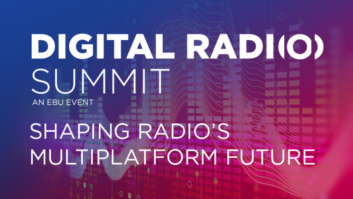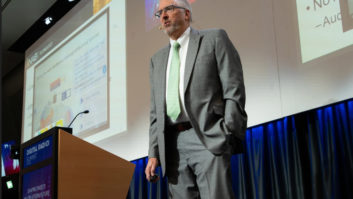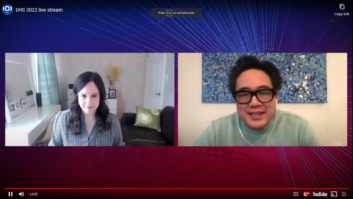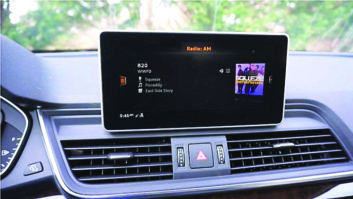
Sure, digital radio continues to advance in the U.S. and worldwide; and the number of digital radios being purchased by consumers, especially in cars, is accelerating.
But David Layer, NAB’s vice president for advanced engineering, cuts to the chase: No broadcaster can afford to be complacent.
“There will come a time, and it will be sooner than we expect, when competition for listeners will be from more than just an audio streaming service or a podcast,” Layer said at the European Broadcasting Union’s Digital Radio Summit in Geneva in February.
TRANSITION STRATEGY
Layer said U.S. radio broadcasters are starting to think about a transition from the current hybrid analog/digital technology to an all-digital implementation.
All-digital would bring a number of advantages to the FM bands too; but at this point, such consideration is more a long-term consideration on FM.
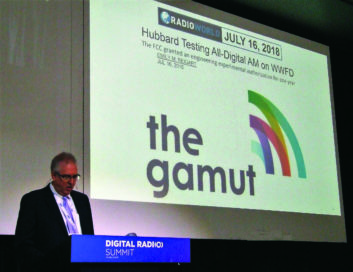
On the other hand, attendees were told, AM band services in the United States are facing immediate challenges both in competing with other services and in earning revenue. Layer described the use of FM translators by AM licensees. That relatively recent change is part of the FCC’s AM revitalization initiatives but also provides a potential transition opportunity, allowing an AM licensee to try all-digital broadcasting while continuing to serve its community on the FM band using analog radio.
Layer reported to the group that in July 2018, WWFD 820 kHz received experimental authority to become a full-time all-digital AM station, as RW has reported.
WWFD “The Gamut” is using an FM translator to reach listeners with analog-only radios. But any of the 60 million HD Radio receivers already sold in the U.S. could receive WWFD’s all-digital AM emissions. Layer showed an impressive video where the WWFD all-digital AM feed is playing through the factory-fit receiver of an Audi Q5.
SO GOOD IN A CAR
Thus, he said, WWFD looks and sounds like the most appealing music streaming service, blending vibrant, crystal-clear sound with crisp cover art and images on the dashboard. (WWFD broadcasts the metadata while the album art image is added in-vehicle by the Audi receiver through a Gracenote database.)
“Thanks to Audi for all the work that they’ve done in making radio so good in a car,” Layer said. “NAB is proactively engaging with automakers and others to imagine further possibilities that take advantage of both over-the-air radio technology and mobile broadband.”
[From Canada to Mexico, Digital Radio Makes Headway]
One of those is radio customization based on user profiles; Layer imagines a time when consumers get into a vehicle and have their preferences, perhaps stored on their smartphone, available effortlessly on the dash and ready to use, no matter where they are.
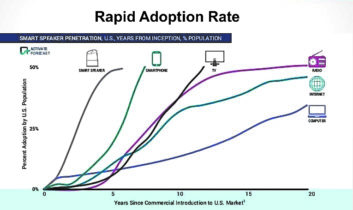
In his opinion, radio broadcasters need to work to enable this kind of future vision. “And not just be on the sidelines while the world changes around them.”
“Let’s consider the Audi Holoride, a backseat virtual reality experience that ties the entertainment being consumed by passengers to the motion of the vehicle, resulting in a thrilling amusement-park-like experience. This kind of development is a wakeup call for radio broadcasters.”
ENABLING OPPORTUNITIES
Brian Savoie, senior director for technology education and outreach at the NAB, described a voice-controlled radio prototype developed through a joint project of NAB and the EBU. Savoie highlighted the role that voice-controlled devices can play in broadcasters’ development strategies.
He said the adoption rate for smart speakers in the United States is likely to be faster than that of any consumer device in history, including smartphones.
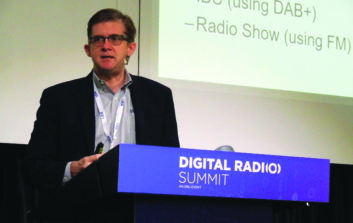
In Savoie’s opinion, the installed base already has provided opportunities for broadcasters to meet their audiences in new spaces and new ways, bringing a noticeable increase of in-home listening to radio streams.
“In the U.S., about 18% of smart speaker owners use their device to engage with local businesses,” said Savoie. “Broadcasters on an advertising-supported model should highly value this information.”
According to a Gartner forecast, by 2020, 70% of U.S. households will own a smartspeaker, though analysts expect the adoption curve eventually to flatten out.
Savoie said devices like smart smoke detectors are embedding high-end speakers and audio technology, allowing different classes of voice-enabled devices to proliferate in the home.
“This way, you won’t necessarily need a smartspeaker,” he concluded. “So when focusing on the opportunities that these types of technologies allow, simply looking at the smartspeaker may be too narrow-focused.”
A.I. IS IN THE CAR
Savoie also said Amazon is looking to extend Alexa into cars as part of their infotainment systems. Using various forms of A.I. — for example, face recognition — they could authenticate a user as soon as he or she enters the car, with no other action required.
The system could then download that profile information and personalize the experience, applying favorite, customized presets for environmental controls and, hopefully, radio presets, playlists and podcasts.
Since connected cars have different levels of internet access, Amazon is working on basic offline Alexa services that users should be able to access even when no wireless service is available.
“What impact could this have for radio?” Savoie said. “We all would like users to still be able to tune to a radio station even when they are out of internet connection. How to do that is something we are talking about. Broadcasters need to examine the services Amazon is developing, ensuring that radio’s place in this environment is properly understood.”







